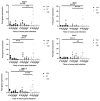Assessment of Biofilm Formation by Candida albicans Strains Isolated from Hemocultures and Their Role in Pathogenesis in the Zebrafish Model
- PMID: 36294579
- PMCID: PMC9605499
- DOI: 10.3390/jof8101014
Assessment of Biofilm Formation by Candida albicans Strains Isolated from Hemocultures and Their Role in Pathogenesis in the Zebrafish Model
Abstract
Candida albicans, an opportunistic pathogen, has the ability to form biofilms in the host or within medical devices in the body. Biofilms have been associated with disseminated/invasive disease with increased severity of infection by disrupting the host immune response and prolonging antifungal treatment. In this study, the in vivo virulence of three strains with different biofilm formation strengths, that is, non-, weak-, and strong biofilm formers, was evaluated using the zebrafish model. The survival assay and fungal tissue burden were measured. Biofilm-related gene expressions were also investigated. The survival of zebrafish, inoculated with strong biofilms forming C. albicans,, was significantly shorter than strains without biofilms forming C. albicans. However, there were no statistical differences in the burden of viable colonogenic cell number between the groups of the three strains tested. We observed that the stronger the biofilm formation, the higher up-regulation of biofilm-associated genes. The biofilm-forming strain (140 and 57), injected into zebrafish larvae, possessed a higher level of expression of genes associated with adhesion, attachment, filamentation, and cell proliferation, including eap1, als3, hwp1, bcr1, and mkc1 at 8 h. The results suggested that, despite the difference in genetic background, biofilm formation is an important virulence factor for the pathogenesis of C. albicans. However, the association between biofilm formation strength and in vivo virulence is controversial and needs to be further studied.
Keywords: Candida albicans; biofilm; gene; virulence; zebrafish.
Conflict of interest statement
The authors declare no conflict of interest. The funder had no any role in the design, data collection, analysis, or interpretation regarding the study or in the manuscript preparation.
Figures



Similar articles
-
Inhibitory effect of lactobacilli supernatants on biofilm and filamentation of Candida albicans, Candida tropicalis, and Candida parapsilosis.Front Microbiol. 2023 Feb 13;14:1105949. doi: 10.3389/fmicb.2023.1105949. eCollection 2023. Front Microbiol. 2023. PMID: 36860488 Free PMC article.
-
Analysis of Biofilm-Related Genes and Antifungal Susceptibility Pattern of Vaginal Candida albicans and Non-Candida albicans Species.Biomed Res Int. 2021 May 28;2021:5598907. doi: 10.1155/2021/5598907. eCollection 2021. Biomed Res Int. 2021. PMID: 34136569 Free PMC article.
-
Critical role of Bcr1-dependent adhesins in C. albicans biofilm formation in vitro and in vivo.PLoS Pathog. 2006 Jul;2(7):e63. doi: 10.1371/journal.ppat.0020063. PLoS Pathog. 2006. PMID: 16839200 Free PMC article.
-
Relative Abundances of Candida albicans and Candida glabrata in In Vitro Coculture Biofilms Impact Biofilm Structure and Formation.Appl Environ Microbiol. 2018 Apr 2;84(8):e02769-17. doi: 10.1128/AEM.02769-17. Print 2018 Apr 15. Appl Environ Microbiol. 2018. PMID: 29427422 Free PMC article.
-
[Genetic regulatory mechanisms of Candida albicans biofilm formation].Sheng Wu Gong Cheng Xue Bao. 2017 Sep 25;33(9):1567-1581. doi: 10.13345/j.cjb.170122. Sheng Wu Gong Cheng Xue Bao. 2017. PMID: 28956402 Review. Chinese.
Cited by
-
Synergistic Effect of Plant Compounds in Combination with Conventional Antimicrobials against Biofilm of Staphylococcus aureus, Pseudomonas aeruginosa, and Candida spp.Pharmaceuticals (Basel). 2023 Oct 30;16(11):1531. doi: 10.3390/ph16111531. Pharmaceuticals (Basel). 2023. PMID: 38004397 Free PMC article. Review.
-
Biofilm: The invisible culprit in catheter-induced candidemia.AIMS Microbiol. 2023 May 11;9(3):467-485. doi: 10.3934/microbiol.2023025. eCollection 2023. AIMS Microbiol. 2023. PMID: 37649801 Free PMC article. Review.
-
Antifungal Properties of Hydrazine-Based Compounds against Candida albicans.Antibiotics (Basel). 2023 Jun 12;12(6):1043. doi: 10.3390/antibiotics12061043. Antibiotics (Basel). 2023. PMID: 37370362 Free PMC article.
-
Characterization of susceptibility patterns and adaptability of the newly emerged Candida auris.Int Microbiol. 2025 Mar;28(3):575-587. doi: 10.1007/s10123-024-00563-1. Epub 2024 Aug 7. Int Microbiol. 2025. PMID: 39107585 Free PMC article.
-
Characterization of Oral Candida spp. Biofilms in Children and Adults Carriers from Eastern Europe and South America.Antibiotics (Basel). 2023 Apr 22;12(5):797. doi: 10.3390/antibiotics12050797. Antibiotics (Basel). 2023. PMID: 37237699 Free PMC article.
References
-
- Almirante B., Rodríguez D., Park B.J., Cuenca-Estrella M., Planes A.M., Almela M., Mensa J., Sanchez F., Ayats J., Gimenez M., et al. Epidemiology and predictors of mortality in cases of Candida bloodstream infection: Results from population-based surveillance, Barcelona, Spain, from 2002 to 2003. J. Clin. Microbiol. 2005;43:1829–1835. doi: 10.1128/JCM.43.4.1829-1835.2005. - DOI - PMC - PubMed
-
- Leroy O., Gangneux J.P., Montravers P., Mira J.P., Gouin F., Sollet J.P., Carlet J., Reynes J., Rosenheim M., Regnier B., et al. Epidemiology, management, and risk factors for death of invasive Candida infections in critical care: A multicenter, prospective, observational study in France (2005–2006) Crit. Care Med. 2009;37:1612–1618. doi: 10.1097/CCM.0b013e31819efac0. - DOI - PubMed
Grants and funding
LinkOut - more resources
Full Text Sources

